Towards Fossil Free Cities—A Supermarket, Greenhouse & Dwelling Integrated Energy System as an Alternative to District Heating: Amsterdam Case Study
Abstract
1. Introduction
2. Materials and Methods
2.1. Scope: Urban Components
2.1.1. Greenhouse
2.1.2. Supermarket Building
2.1.3. Dwelling
2.2. Performance Indicator
2.3. Energy Balances
2.3.1. Energy Balances: Supermarket
2.3.2. Energy Demand: Dwellings
2.3.3. Energy Balance: Greenhouse
2.4. Energy Profiles
2.5. System Integration
2.5.1. Aquifer Thermal Energy Storage
2.5.2. System Configuration
2.5.3. System Configuration: Winter
2.5.4. System Configuration: Summer
2.5.5. System Configuration: Additional Electricity Demand
2.6. System Configuration: Balance
3. Results
3.1. Scenario 1: Carbon Footprint Business as Usual (BAU)
3.2. Scenario 2: Environmental Footprint Greenhouse Solar Collector
3.3. Scenario 3: Environmental Footprint Amsterdam District Heating
3.4. Configuration: Optimal Growing Climate or Optimal Energy Performance
4. Discussion
4.1. Sensitivity Analysis (SA) Assumed Parameters
4.2. Research Relevance
4.2.1. Societal Relevance
4.2.2. Scientific Relevance
4.3. Outlook
4.3.1. Upscaling the System and Future Use
4.3.2. FEW Nexus Assessment: Avoided Food Miles
4.3.3. Agricultural Productivity
5. Conclusions
Author Contributions
Funding
Acknowledgments
Conflicts of Interest
Nomenclature
| Symbol | Unit | Description |
| ATES | - | Aquifer Thermal Energy Storage |
| BAU | - | Business as Usual |
| CO2e | - | Carbon dioxide equivalent |
| COP | - | Coefficient of Performance |
| DHW/SH | - | Domestic Hot Water/Space Heating |
| GH/DW/SM | - | Greenhouse/Dwelling/Supermarket |
| hh | - | household |
| PAR | - | Photo Active Radiation |
| PPFD | - | Photosynthetic Photon Flux Density |
| W/m2K4 | Hemispherical Stefan-Boltzmann constant: 5.67 × 10−8 | |
| Pa | Water vapour pressure | |
| - | Climate specific standard values. For a sea climate, a = 0.55 and b = 0.005 | |
| ρcon | kg/m3 | Density concrete: 2500 kg/m3 |
| ρair | kg/m3 | Density air: 1.21 kg/m3 |
| ηrec | - | Recovery efficiency ATES storage, set to 0.75 |
| ηcar | - | Heat pump Carnot efficiency, set to 0.5 |
| η1 | - | Heat exch. eff. SM flow > GH air (HE1, Figure 6), set to 0.9 |
| η2 | - | Heat exch. eff. ATES loop > GH loop and DW loop (HE2, Figure 6), set to 0.9 |
| η3 | - | Heat exch. eff. SM flow > DW loop (HE3, Figure 6), set to 0.9. |
| Wlights | W | Power crop growing lights (54 W/m2 in this study) |
| vwind | m/s | Wind velocity (NEN5060 data) |
| qinf | m3/m2/s | Air exchange with environment due to infiltration |
| Vair | m3 | Air volume |
| Vinf | m3/s | Air exchange volume due to infiltration (supermarket calculations) |
| Vvent | m3/s | Air exchange volume due to ventilation (supermarket calculations) |
| U(n) | W/m2·K | Rate of transfer of heat through structure n |
| Tmin-P | °C | Minimum greenhouse indoor temperature, photoperiod. |
| Tmin-D | °C | Minimum greenhouse indoor temperature, dark period |
| Tmax | °C | Maximum greenhouse temperature |
| Tlow | °C | Approach temperature heat pump |
| Tin | °C | Indoor temperature greenhouse |
| Thigh | °C | Upgrade temperature heat pump |
| Te | °C | Outside ambient air temperature (NEN5060 climate data) |
| Tair | °C | Assumed air temperature of waste energy flow supermarket, set to 35 °C |
| rPAR | - | Coefficient to filter out solar radiation in the PAR range |
| ro | - | Façade orientation reduction coefficient (see Table A1) |
| qtrans | W | Thermal energy flux due to temperature difference interior-exterior |
| qsun | W/m2 | Thermal heat gain by solar irradiation |
| qsky | W/m2 | Atmospheric long-wave irradiation |
| qper | W | Thermal heat load per person present |
| qlight | W/m2 | Thermal heat load by active lights, supermarket |
| QLIDL_C | kWhT | Cooling energy demand supermarket, i.e., energy provided |
| qinf | W | Energy flux due to air infiltration through façade construction |
| QGH_C_ATES | kWh | Cooling energy demand greenhouse (GH), supplied by the ATES |
| qeq | W/m2 | hermal heat load by active equipment |
| qem | W | Energy flux due to sky emissivity |
| np | - | Number of workers/customers present |
| M( ) | kg | Mass |
| Isun | W/m2 | Total incoming global horizontal irradiance (NEN5060 climate data) |
| gglass | - | Solar transmittance coefficient.: fraction of the solar radiation that passes the glass |
| f(n) | - | Active/Inactive coefficient for GH and SM internal heat loads, set to (1) or (0) |
| E | kWhe | Required electrical investment heat pump |
| cLED | % | Efficiency crop growing lights |
| ccon | J/(kg·K) | heat capacity concrete, this study applies 840 J/kg·K |
| cair | J/(kg·K) | heat capacity air, this study applies 1005 J/kg·K |
| A(n) | m2 | surface area, façade or floor (Aglass/Afloor) |
| ∑QGH_H_ATES | kWht/year | Thermal energy demand greenhouse (GH) supplied by the ATES |
| ∑QDW_H_ATES | kWht/year | Thermal energy demand dwelling (DW), supplied by the ATES |
| ∑QATES_H | kWht/year | Total thermal energy stored in the ATES |
| ∑QATES_C | kWhc/year | Total cooling energy stored in the ATES |
| - | Emissivity of greenhouse cover material. Set to 0.97 for single pane glazing | |
| °C | Sky temperature at (t) | |
| - | Relative Humidity at (t), retrieved from NEN5060 climate reference data | |
| Pa | Saturated water vapour pressure | |
| - | Sky view factor. Set to 0.5 for an unobstructed hemispherical dome |
Appendix A. Energy Balance Equations
Appendix A.1. Supermarket Energy Balance

Appendix A.2. Greenhouse Energy Balance
| Facade | Material | U-Value (W/m2·K) | Solar Transmittance | Greenhouse Main Geometry | ||
|---|---|---|---|---|---|---|
| Roof | single glazing | 851 | 5.70 | 0.65 | 0.9 | 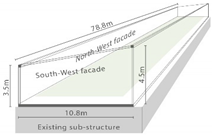 |
| North-East | single glazing | 32 | 5.70 | 0.65 | 0.5 | |
| North-West | single glazing | 197 | 5.70 | 0.65 | 0.5 | |
| South-East | single glazing | 276 | 5.70 | 0.65 | 0.7 | |
| South-West | single glazing | 32 | 5.70 | 0.65 | 0.7 | |
| Floor | concrete 1 | 851 | 0.20 | n.a. | n.a. |
References
- IPCC. Global warming of 1.5 °C-Summary for Policymakers. Rep. Intergov. Panel Clim. Chang. 2018. [Google Scholar] [CrossRef]
- Albers, R.A.W. Overview of challenges and achievements in the climate adaptation of cities and in the Climate Proof Cities program. Build. Environ. 2015, 83, 1–10. [Google Scholar] [CrossRef]
- UNFCCC. Convention on Climate Change: Climate Agreement of Paris; Paris Agreement: Paris, France, 2015. [Google Scholar]
- IPCC. Nationale Broeikasgasemissies Volgens IPCC. Rijksoverheid. 2019. Available online: http://www.emissieregistratie.nl/erpubliek/erpub/international/broeikasgassen.aspx (accessed on 1 October 2019).
- Gemeente Amsterdam. Routekaart-Amsterdam Klimaatneutraal 2050; Gemeente Amsterdam—Ruimte & Duurzaamheid: Amsterdam, The Netherlands, 2019. [Google Scholar]
- Gemeente Amsterdam. Naar een Stad Zonder Aardgas-Strategie voor de Verduurzaaming van de Warmtevoorziening in de Gebouwde Omgeving; Gemeente Amsterdam: Amsterdam, The Netherlands, 2016. [Google Scholar]
- Broersma, S.; Fremouw, M. The City-Zen approach for urban energy master plans addressing technical opportunities + non-technical barriers. In Proceedings of the 5th CIB International Conference on Smart and Sustainable Built Environments, Pretoria, South Africa, 9–11 December 2015; pp. 1–10. [Google Scholar]
- van den Dobbelsteen, A.; Broersma, S.; Fremouw, M.; Blom, T.; Sturkenboom, J.; Martin, C.L. The City-Zen urban energy transition methodology—The Amsterdam roadmap towards a zero-carbon city. In SASBE 2018; Smart & Sustainable Built Environment (SASBE): Sydney, Australia, 2018; pp. 164–176. [Google Scholar]
- Solomon, B.D.; Krishna, K. The coming sustainable energy transition: History, strategies, and outlook. Energy Policy 2011, 39, 7422–7431. [Google Scholar]
- van den Dobbelsteen, A.; Broersma, S.; Tillie, N.; Fremouw, M. The Energy Master Plan: Transition to self-sufficient city regions by means of an approach to local energy potentials. In Proceedings of the 30th International PLEA Conference: Sustainable Habitats for Developing Societies, Achmedabad, India, 16–18 December 2014; pp. 1–8. [Google Scholar]
- van den Dobbelsteen, A.; Martin, C.L.; Keeffe, G.; Pulselli, R.M.; Vandevyvere, H. From Problems to Potentials—The Urban Energy Transition of Gruž, Dubrovnik. Energies 2018, 11, 1–13. [Google Scholar]
- van den Dobbelsteen, A. Towards closed cycles—New strategy steps inspired by the Cradle to Cradle approach. In Proceedings of the PLEA 2008—25th PLEA International Conference on Passive and Low Energy Architecture, Dublin, Ireland, 24–28 October 2008. [Google Scholar]
- Lysen, E.H. Trias Energica: Solar Energy Strategies for Developing Countries. In Proceedings of the Eurosun Conference, Freiburg, Germany, 16 September 1996; pp. 1–6. [Google Scholar]
- Duijvestein, K. An ecological approach to building. In Appropriate Technology in Industrialized Countries; Riedijk, W., Boes, J., Ravesteijn, W., Eds.; Delft University Press: Delft, The Netherlands, 1989; pp. 1–6. [Google Scholar]
- Tillie, N.; van den Dobbelsteen, A.; Doepel, D.; de Jager, W.; Joubert, M.; Mayenburg, D. REAP Rotterdam Energy Approach and Planning Towards CO2-Neutral Urban Development; REAP: Rotterdam, The Netherlands, 2009. [Google Scholar]
- Stremke, S.; van den Dobbelsteen, A.; Koh, J. Exergy landscapes: Exploration of second-law thinking towards sustainable landscape design. Int. J. Energy 2011, 8, 148. [Google Scholar]
- Gommans, L. Gebiedsgerichte Energetische Systeemoptimalisatie—Een Onderzoek Naar de Mogelijkheden Voor een Duurzame Regionale Energietransitie; Technical University of Delft: Delft, The Netherlands, 2012. [Google Scholar]
- Gemeente Amsterdam. Amsterdam City Data. 2019. Available online: https://data.amsterdam.nl/ (accessed on 19 March 2019).
- RIVM. Nationale Energie Atlas. Available online: https://www.nationaleenergieatlas.nl/kaarten (accessed on 21 January 2020).
- Gemeente Amsterdam. Zonatlas Amsterdam. 2019. Available online: https://www.zonatlas.nl/amsterdam/ontdek-de-zonatlas/ (accessed on 19 March 2019).
- Otten, M.; Afman, M. Emissiekentallen Elektriciteit-Kentallen voor Grijze en ‘Niet-Geoormerkte Stroom’ Inclusief Upstream-Emissies; Delft University Press: Delft, The Netherlands, 2015. [Google Scholar]
- Zijlema, P.J. Nederlandse Lijst van Energiedragers en Standaard CO2 Emissiefactoren, Versie Januari 2018; Rijksdienst Voor Ondernemend Nederland: Utrecht, The Netherlands, 2018. [Google Scholar]
- CE Delft. Ketenemissies Warmtelevering-Directe en Indirecte CO2-Emissies van Warmtetechnieken; CE Delft: Delft, The Netherlands, 2016. [Google Scholar]
- World Resources Institute. Global Protocol for Community-Scale Greenhouse Gas Emission Inventories-An accounting and Reporting Standard for Cities; World Resources Institute (WRI) C40 Cities and ICLEI Local Governments for Sustainability: Washington, DC, USA, 2014. [Google Scholar]
- NEN. Hygrothermal Performance of Buildings-Climatic Reference Data, NEN5060; Stichting Koninklijk Nederlands Normalisatie Instituut: Delft, The Netherlands, 2018. [Google Scholar]
- Liander. Consumer Data-Kleinverbruiksdata per Jaar; Liander: Amsterdam, The Netherlands, 2019. [Google Scholar]
- Liander. Dataset-Dagprofielen; Liander: Amsterdam, The Netherlands, 2014. [Google Scholar]
- Majcen, D.; Itard, L.C.M.; Visscher, H. Theoretical vs. actual energy consumption of labelled dwellings in The Netherlands: Discrepancies and policy implications. Energy Policy 2013, 54, 125–136. [Google Scholar] [CrossRef]
- Schepers, B.L.; Naber, N.R.; Rooijers, F.J.; Leguijt, C. Op Weg naar een Klimaatneutrale Gebouwde Omgeving 2050; CE Delft: Delft, The Netherlands, 2015; pp. 1–176. [Google Scholar]
- Sabeh, N.C. Evaluating and Miniziming Water Use by Greenhouse Evaporative Cooling Systems in a Semi-Arid Climate; The University of Arizona: Tucson, AZ, USA, 2007. [Google Scholar]
- Fleuchaus, P.; Godschalk, B.; Stober, I.; Blum, P. Worldwide application of aquifer thermal energy storage—A review. Renew. Sustain. Energy Rev. 2018, 94, 861–876. [Google Scholar]
- Bloemendal, M.; Hartog, N. Analysis of the impact of storage conditions on the thermal recovery efficiency of low-temperature ATES systems. Geothermics 2018, 71, 306–319. [Google Scholar]
- Sommer, W.; Valstar, J.; van Gaans, P.; Grotenhuis, T.; Rijnaarts, H. The impact of aquifer heterogeneity on the performance of aquifer thermal energy storage. Water Resour. Res. 2013, 49, 8128–8138. [Google Scholar] [CrossRef]
- Sommer, W.; Valstar, J.; Leusbrock, I.; Grotenhuis, T.; Rijnaarts, H. Optimization and spatial pattern of large-scale aquifer thermal energy storage. Appl. Energy 2015, 137, 322–337. [Google Scholar]
- van Steekelenburg, A.; Hoogervorst, W.; van Antwerpen, A. Inventarisatie Thermische Wateropslagsystemen Inleiding; HAS Kennistransfer: Hertogenbosch, The Netherlands, 2011. [Google Scholar]
- Sommer, W.T.; Doornenbal, P.J.; Drijver, B.C.; van Gaans, P.F.M.; Leusbrock, I.; Grotenhuis, J.T.C.; Rijnaarts, H.H.M. Thermal performance and heat transport in aquifer thermal energy storage. Hydrogeol. J. 2014, 22, 263–279. [Google Scholar] [CrossRef]
- SenterNovem. Koude/Warmteopslag in de Praktijk-Meetgegevens van 67 Projecten; SenterNovem: Utrecht, The Netherlands, 2007. [Google Scholar]
- RVO. Rapportage Bodemenergiesystemen in Nederland-Analyse van 125 Projecten; Rijksdienst voor Ondernemend Nederland: Utrecht, The Netherlands, 2016. [Google Scholar]
- DWA and IF Technology. Onderzoek Criteria Energiebalans WKO-Eindrapportage. Stichting Kennisontwikkeling en Kennisoverdracht Bodem. 2012. Available online: file:///C:/Users/MDPI/AppData/Local/Temp/onderzoek_criteria_energiebalans-2.pdf (accessed on 11 November 2020).
- Meggers, F.; Ritter, V.; Goffin, P.; Baetschmann, M.; Leibundgut, H. Low exergy building systems implementation. Energy 2012, 41, 48–55. [Google Scholar] [CrossRef]
- Graamans, L.; van den Dobbelsteen, A.; Meinen, E.; Stanghellini, C. Plant factories crop transpiration and energy balance. Agric. Syst. 2017, 153, 138–147. [Google Scholar] [CrossRef]
- Akerboom, S.; van der Linden, F.; Otte, F.; Pront, S.; Beijen, B.; Buijze, A.; Korsse, D.; van Rijswick, M. Onderzoek Naar Gas-en Warmtenetten; Universiteit van Amsterdam—Centrum voor Energievraagstukken: Amsterdam, The Netherlands, 2016. [Google Scholar]
- CE Delft. Verduurzaaming Warmteproductie Diemen—Second opinie CO2-Roadmap; CE Delft: Delft, The Netherlands, 2019. [Google Scholar]
- Gemeente Amsterdam. District Heating and Cooling. 2018. Available online: https://maps.amsterdam.nl/stadswarmtekoude/?LANG=en (accessed on 28 August 2019).
- RIVM. Food Consumption in The Netherlands and its Determinants-Background Report; National Institute for Public Health and the Environment: Bilthoven, The Netherlands, 2017. [Google Scholar]
- van Timmeren, A.; Hackauf, U. Metropolitan FarmCity Reciprocities-Towards interconnected urban and peri-urban farming typologies. In Why We Need Small Cows-Ways to Design for Urban Agriculture; Roggema, R., Keeffe, G., Eds.; VHL University of Applied Sciences: Lowalden, The Netherlands, 2014; pp. 99–134. [Google Scholar]
- Zhang, P.; Zhang, L.; Chang, Y.; Xu, M.; Hao, Y.; Liang, S.; Liu, G.; Yang, Z.; Wang, C. Food-energy-water (FEW) nexus for urban sustainability: A comprehensive review. Resour. Conserv. Recycl. 2019, 142, 215–224. [Google Scholar] [CrossRef]
- Rees, J. Geography and the nexus: Presidential Address and record of the Royal Geographical Society (with IBG) AGM 2013. Geogr. J. 2013, 179, 279–282. [Google Scholar] [CrossRef]
- Leck, H.; Conway, D.; Bradshaw, M.; Rees, J. Tracing the Water-Energy-Food Nexus: Description, Theory and Practice. Geogr. Compass 2015, 9, 445–460. [Google Scholar] [CrossRef]
- Terrapon-Pfaff, J.; Ortiz, W.; Dienst, C.; Gröne, M.-C. Energising the WEF nexus to enhance sustainable development at local level. J. Environ. Manag. 2018, 223, 409–416. [Google Scholar] [CrossRef]
- Hang, M.Y.L.P.; Martinez-Hernandez, E.; Leach, M.; Yang, A. Insight-Based Approach for the Design of Integrated Local Food-Energy-Water Systems. Environ. Sci. Technol. 2017, 51, 8643–8653. [Google Scholar] [CrossRef]
- Gondhalekar, D.; Ramsauer, T. Nexus City: Operationalizing the urban Water-Energy-Food Nexus for climate change adaptation in Munich, Germany. Urban Clim. 2017, 19, 28–40. [Google Scholar] [CrossRef]
- Ten Caat, P.N.; Tillie, N.M.J.D.; Tenpierik, M.J. Pig farming vs Solar farming: Exploring novel opportunities for the energy transition [In Review]. In transFEWmation; Roggema, R., Ed.; Springer: Berlin/Heidelberg, Germany, 2020; pp. 1–23. [Google Scholar]
- ASHRAE. Chapter 29: Nonresidential Cooling and Heating Load Calculation Procedures. In ASHRAE Fundamentals Handbook; American Society of Heating, Refrigerating and Air-Conditioning Engineers: Atlanta, GA, USA, 2001; pp. 29.1–29.38. [Google Scholar]
- Graamans, L.; Baeza, E.; van den Dobbelsteen, A.; Tsafaras, I.; Stanghellini, C. Plant factories versus greenhouses: Comparison of resource use efficiency. Agric. Syst. 2018, 160, 31–43. [Google Scholar] [CrossRef]
- Hemming, S.; Dueck, T.; Marissen, N.; Jongschaap, R.; Kempkes, F. Diffuus Licht-Het Effect van Lichtverstrooiende Kasdekmaterialen op Kasklimaat, Lichtdoordringing en Gewasgroei—Rapport 557; Agrotechnology & Food Innovations: Wageningen, The Netherlands, 2005. [Google Scholar]
- Stanghellini, C.; Ooster, B.V.; Heuvelink, E. Greenhouse Horticulture-Technology for Optimal Crop Production, 1st ed.; Wageningen Acedemic Publishers: Wageningen, The Netherlands, 2018. [Google Scholar]
- Brunt, D. Notes on Radiation in the Atmosphere. I. Quaterly J. R. Meteorol. Soc. 1932, 58, 389–420. [Google Scholar] [CrossRef]
- Buck, A.L. Buck Research Manual-Updated Equation from Buck (1981) New Equations for Computing Vapor Pressure and Enhancement Factor. 1996. Available online: http://www.hygrometers.com/wp-content/uploads/CR-1A-users-manual-2009-12.pdf (accessed on 11 November 2020).
- Penman, H.L. Evaporation in Nature. Rep. Prog. Phys. 1947, 11, 366–388. [Google Scholar] [CrossRef]
- Penman, H.L. Natural evaporation from open water, bare soil and grass. Proc. R. Soc. Lond. Ser. A Math. Phys. Sci. 1948, 193, 120–145. [Google Scholar]
- Stanghellini, C. Transpiration of Greenhouse Crops-An Aid to Climate Management; Wagening University of Agriculture: Wageningen, The Netherlands, 1987. [Google Scholar]
- Boulard, T.; Wang, S. Greenhouse crop transpiration simulation from external climate conditions. Agric. For. Meteorol. 2000, 100, 25–34. [Google Scholar] [CrossRef]
- Seginer, I. The Penman–Monteith Evapotranspiration Equation as an Element in Greenhouse Ventilation Design. Biosyst. Eng. 2002, 82, 423–439. [Google Scholar] [CrossRef]
- Thimijan, R.W.; Heins, R.D. Photometric, Radiometric and Quantum Light Units of Measure A Review of Procedures for Interconversion. HortScience 1983, 18, 818–820. [Google Scholar]

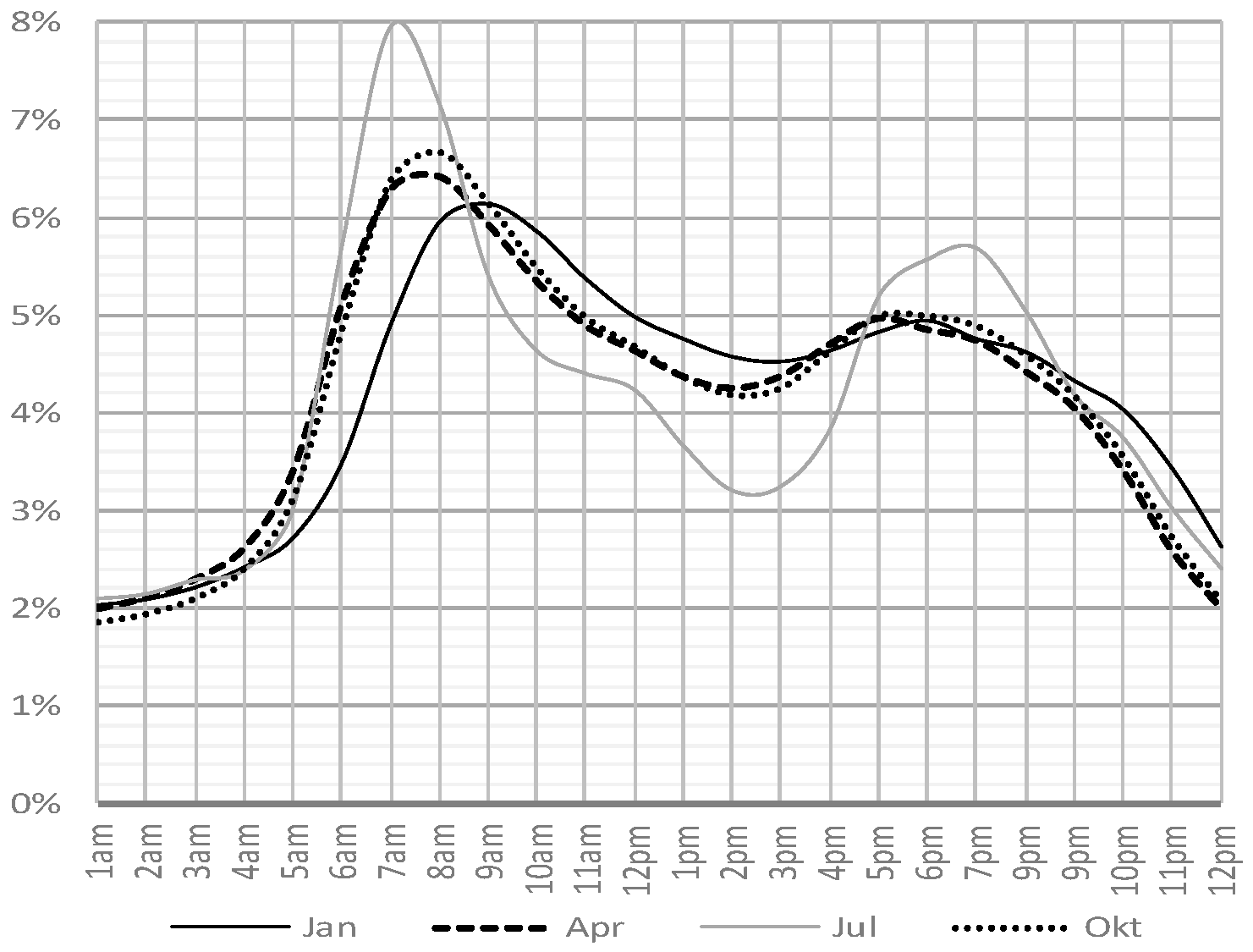
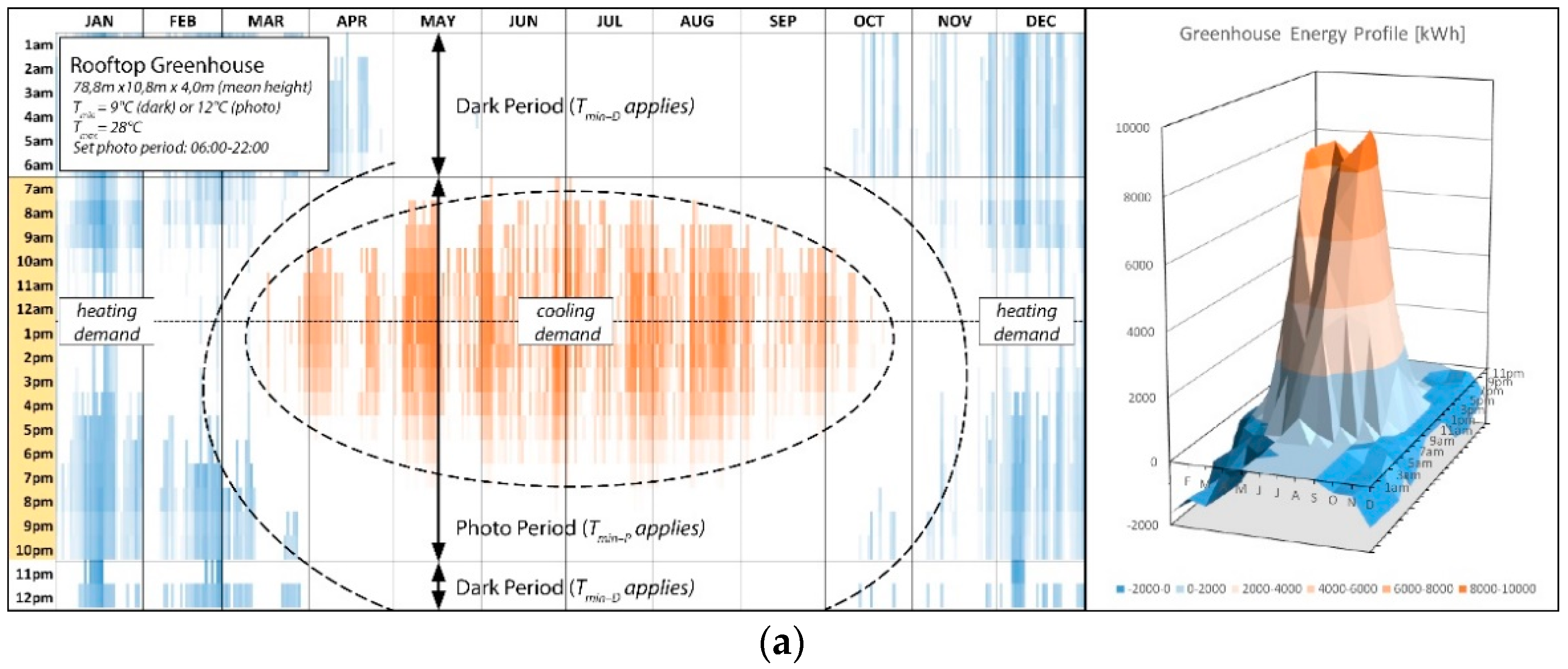
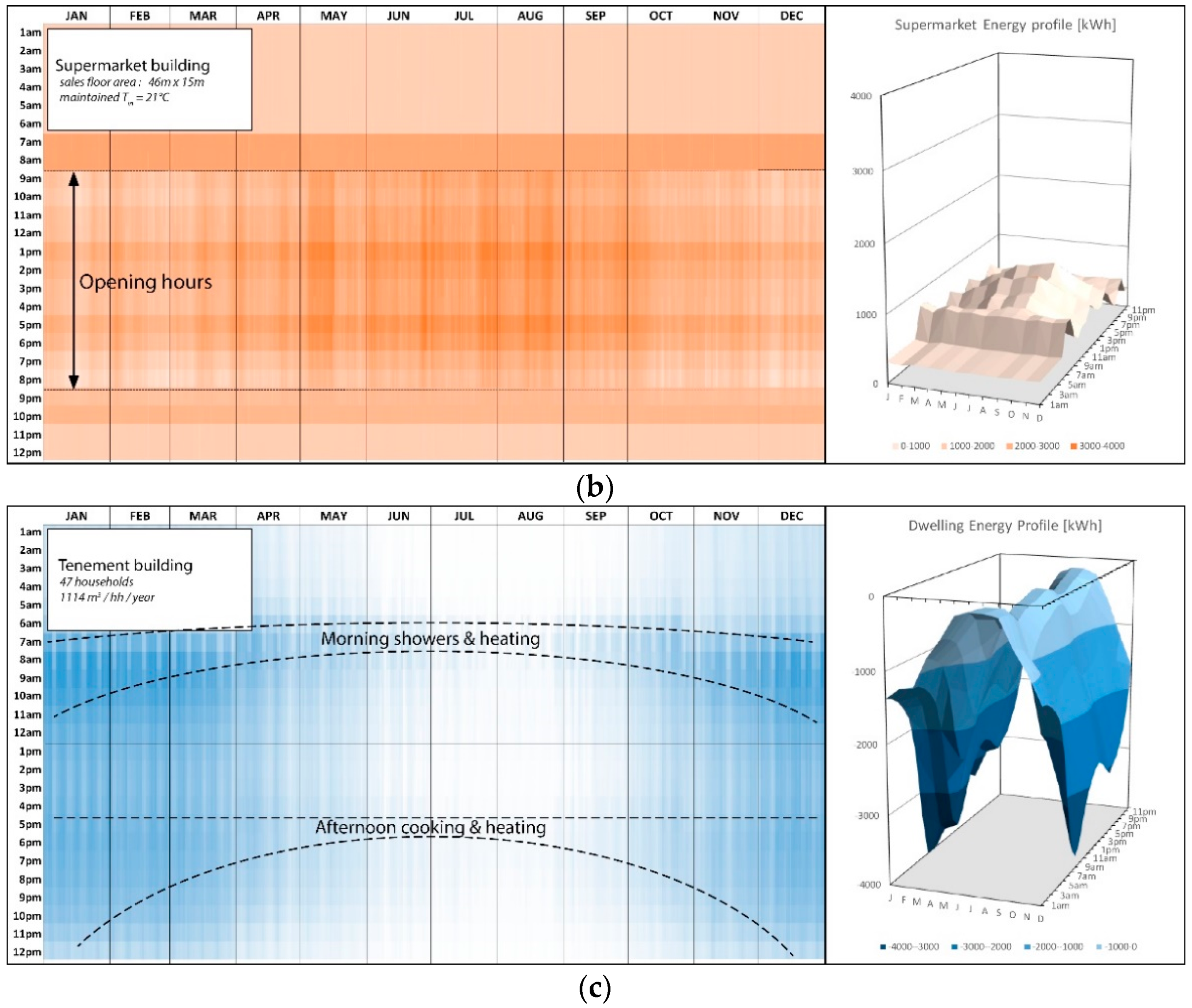
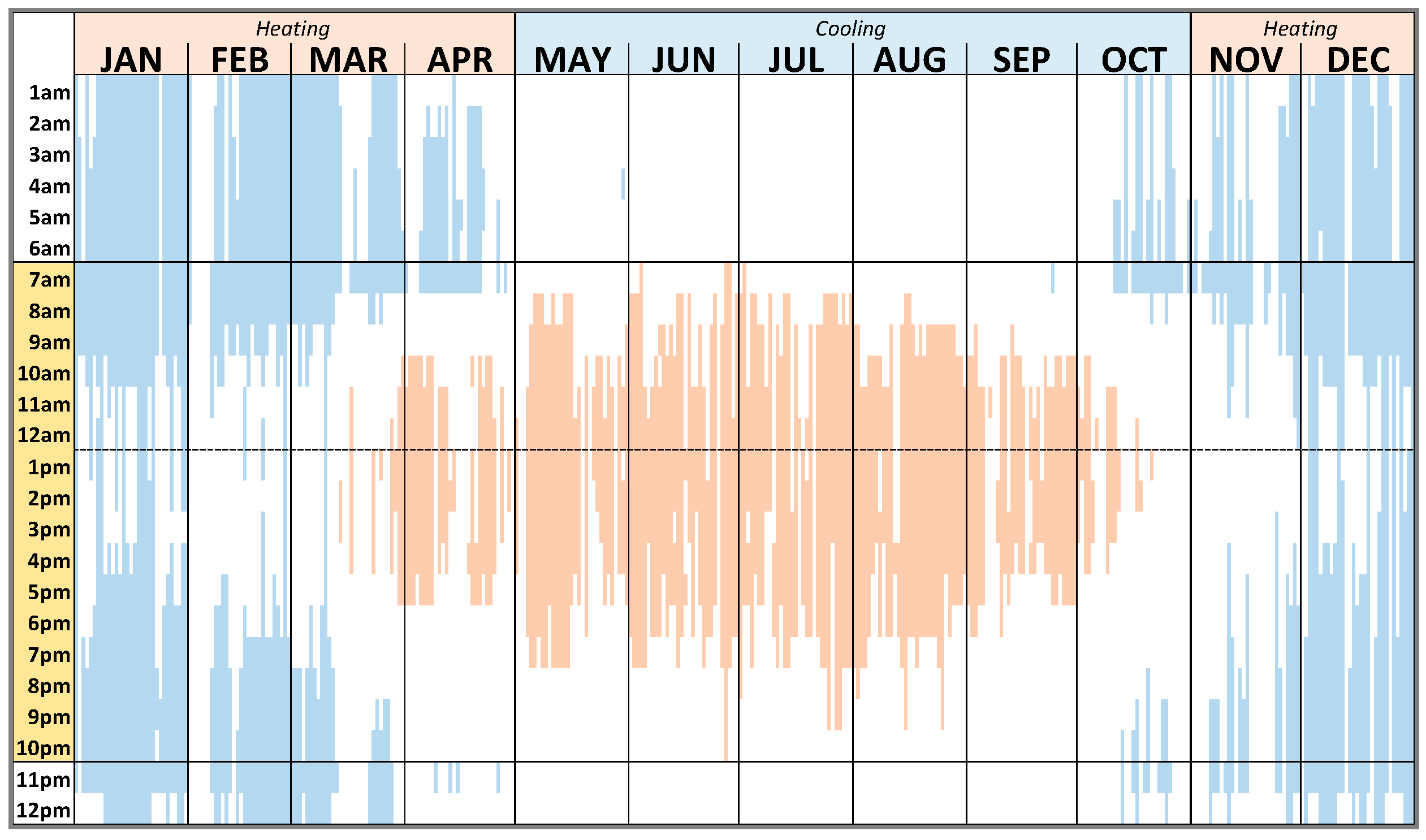
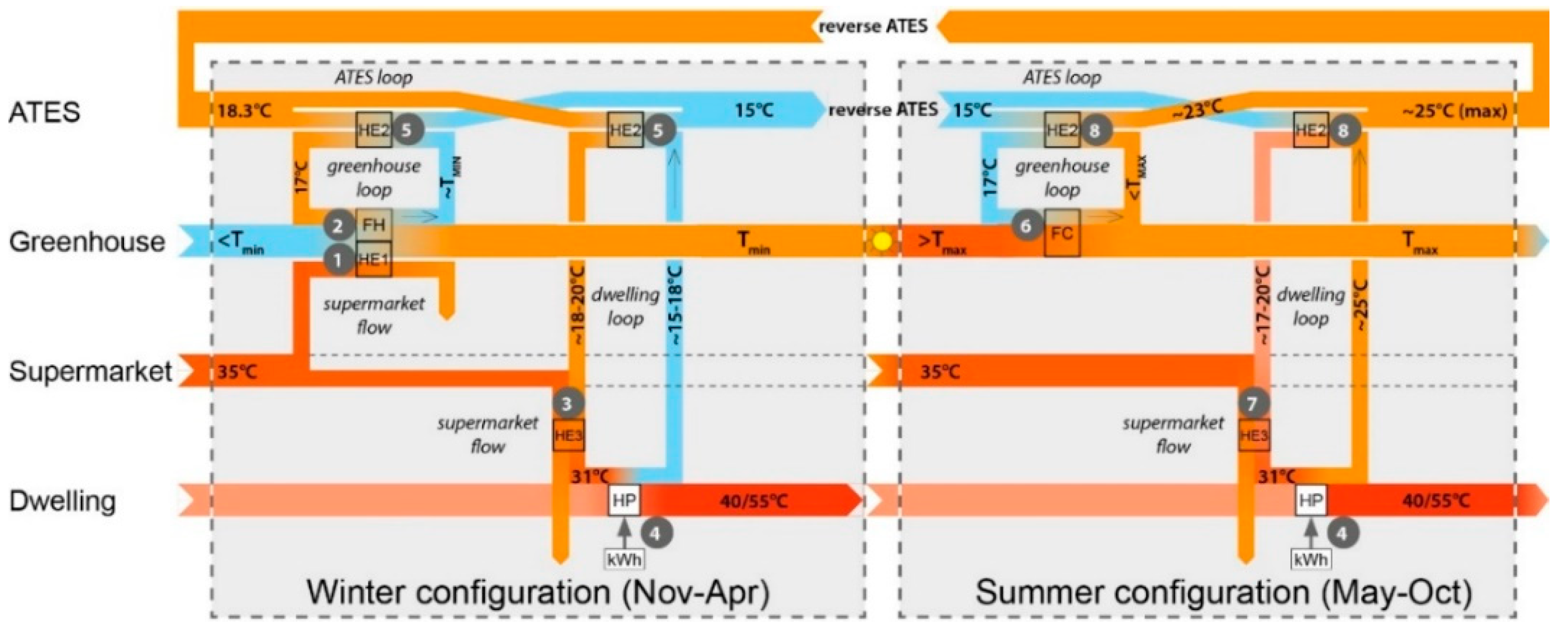
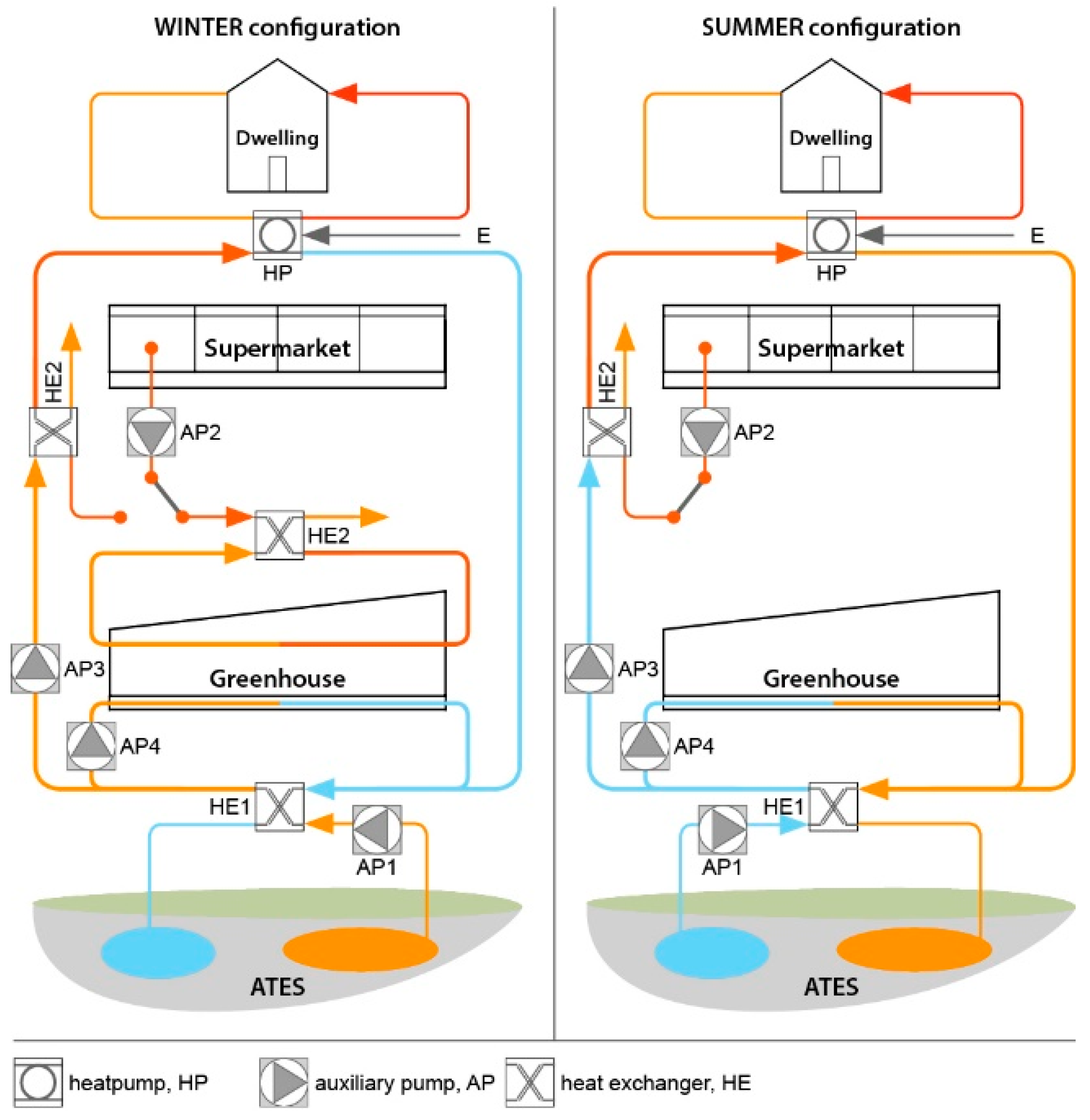

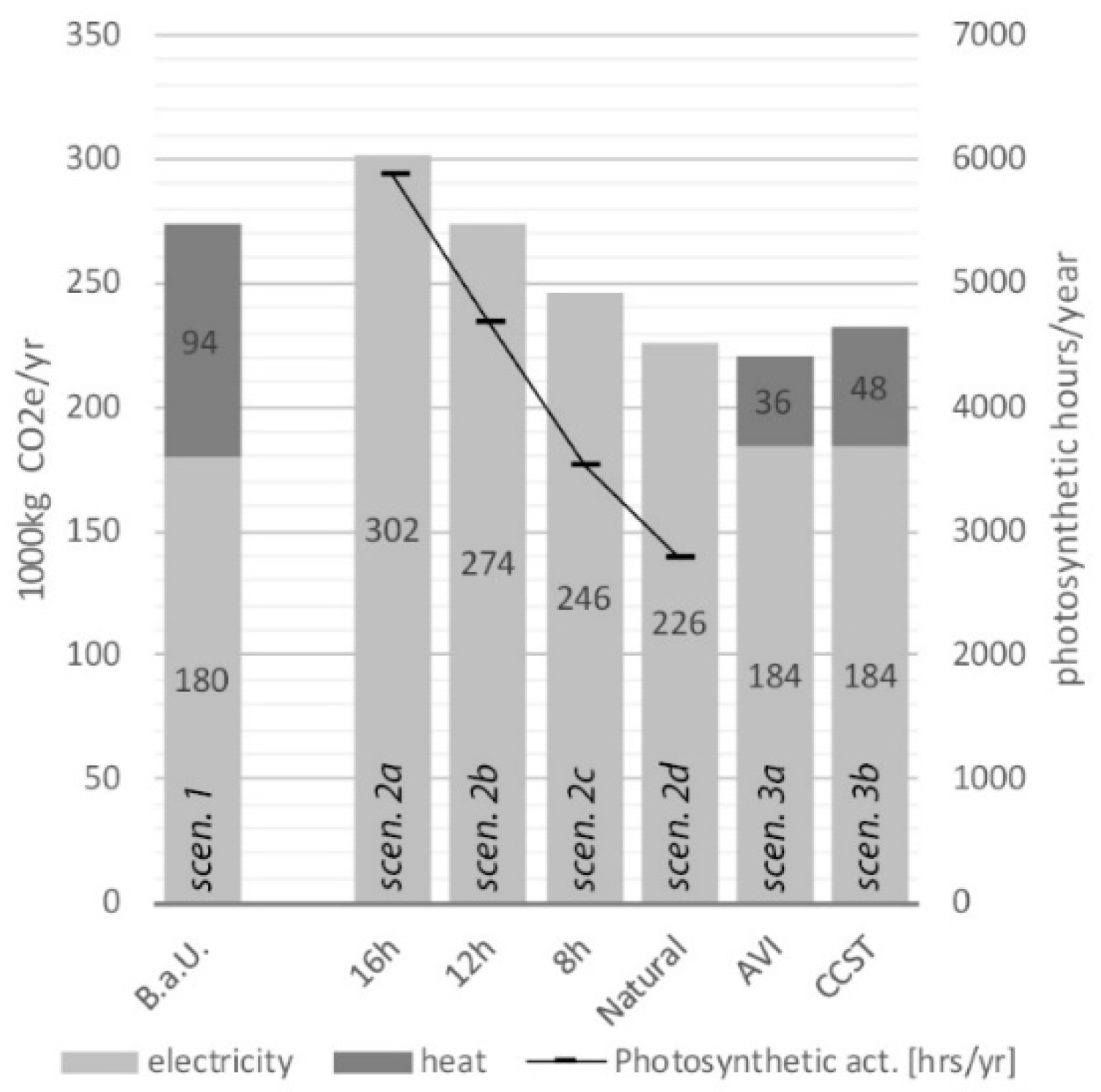
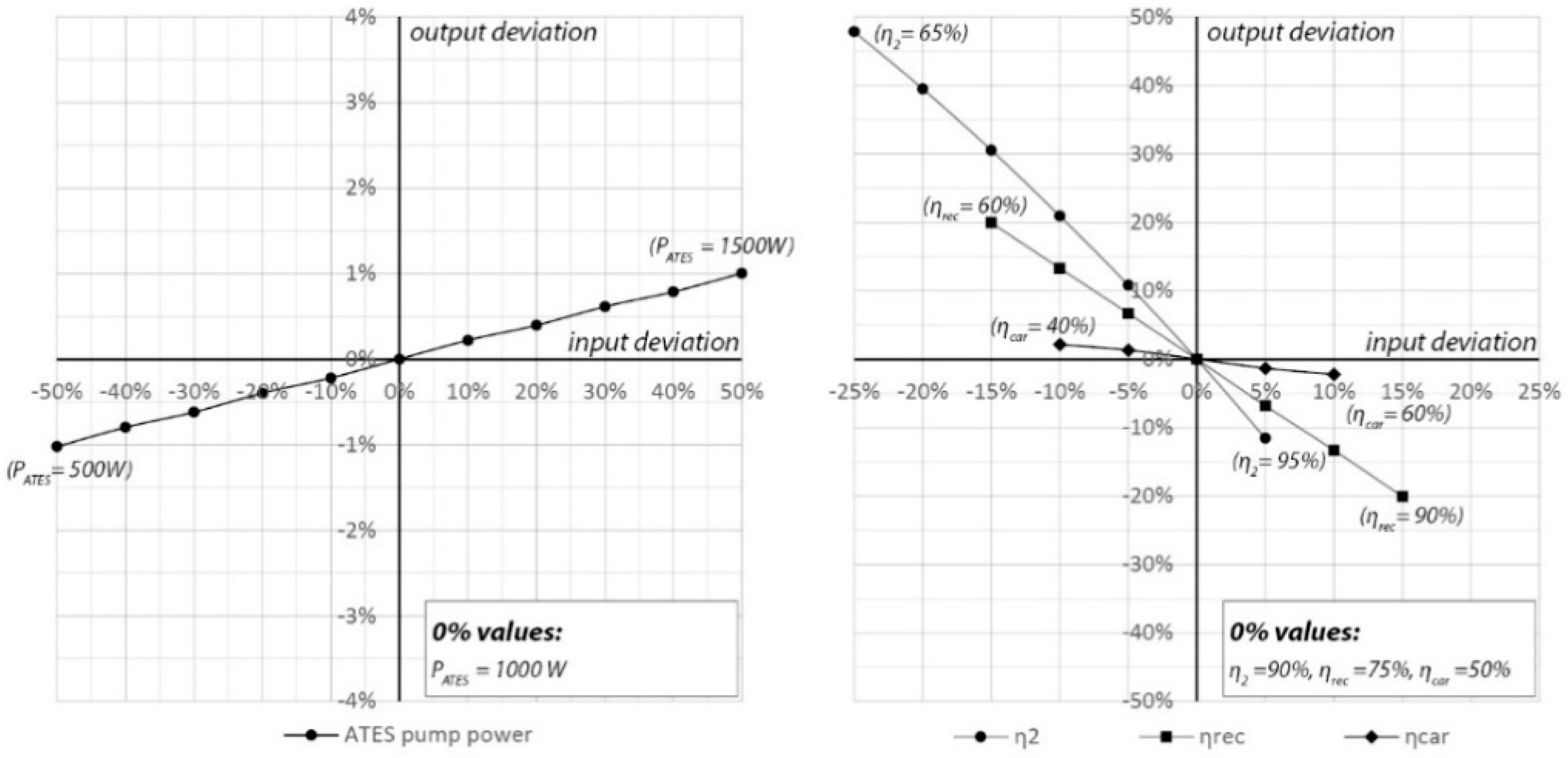
| Dwellings (Section 2.1.3) | Supermarket (Section 2.1.2) | Rooftop Greenhouse (Section 2.1.1) |
|---|---|---|
| (1) Tenement building (1926), 5 floors 47 hous-holds 1 Current average energy label: E or D (range G–D) 3 (energy label varies per cluster) (2) Gallery building (1965), 6 floors 68 households 1 Current average energy label: C (range D–B) 3 | Lidl Helmersbuurt (constructed in 2007) Inner dimensions: 15.4 m × 46.0 m × 2.9 m Sales floor area: 715 m2 Located at the ground floor of the city block | Conventional closed greenhouse. Located at the rooftop of the residential buildings. Max. dimensions 2 : (1) Rooftop tenement building: 10.8 × 78.8 = 851 m2 (2) Rooftop gallery building: 8.0 × 107.0 = 856 m2 |
| Energy | Product/Activity | Carbon Footprint | Unit | Note |
|---|---|---|---|---|
| Electric | Dutch national grid mix electricity | 0.526 | kg CO2e/kWh | Country specific value (chain emissions and network losses included) [21] |
| Thermal | Natural gas (dry) | 1.788; 56.6 | kg CO2e/m3; kg/GJth | Country specific value, 2018 value used (annually updated) [22] |
| Thermal | District heating, CCGT 1 fueled | 36.0 | kg CO2e/GJ | [23] See Section 3.2 (power plant) |
| Thermal | District heating, AVI 2 fueled | 26.5 | kg CO2e/GJ | [23] See Section 3.2 (waste incineration) |
| Building: (See Figure 1) | N hh | Average; Total Elec. Demand | Average; Total Gas Demand | Average E-Label | Label Range | Post-Renov. Label | Reduction Gas Demand |
|---|---|---|---|---|---|---|---|
| (1) Gallery flat Eerste-Helmersstraat | 68 | 1697 kWh/hh/year; 115.396 kWh/year | 717 m3/year; 48.800 m3/year | C | D–B | B | −7% (C > B) |
| (2) Tenement Tweede-Helmersstraat | 47 | 1805 kWh/hh/year; 84.835 kWh/year | 1114 m3/year; 52.400 m3/year | E or D | G–D | B | −24% (D > B) −28% (E > B) |
| Factor | Value | When | Note/Formula |
|---|---|---|---|
| winter configuration | |||
| 18.3 °C | If greenhouse | ATES temperature drop is assumed 3 °C. ATES extraction temperature () depends on GH cooling set point temperature: , so (26 °C × 0.9−3 °C) × 0.9 = 18.3 °C (for scenario 2b–d) | |
| 31.4 °C | If greenhouse | Supermarket excess energy temperature = set to 35 °C , so 35 °C × 0.9 = 31.4 °C | |
| 45 °C | Set-point temperature for SH | Based on medium-temperature dwelling heating system | |
| 55 °C | Set-point temperature for DHW | The weekly temp. boost (T = 65 °C) is not accounted for. | |
| summer configuration | |||
| 31 °C | Full duration summer period | , i.e., 35 °C × 0.9 = 31.4 °C | |
| 45 °C/55 °C | As winter configuration | As winter configuration. | |
| Component, Medium (See Figure 5 and Figure 6) | Part/Description | Symb. in Figure 6 | In Operation, Description | Power (W), (W/m2) | Operational Hours | Annual Demand (kWhE) |
|---|---|---|---|---|---|---|
| (1) ATES doublet loop, warm/cold water | Water pump, warm > cold and vice-versa () | AP1 | 24/7 (2 possible settings) | 1000 W 2 | 8760 | 8760 |
| (2) Supermarket flow, warm air | AC system > GH or DW, (HE2 connected) | AP2 | 24/7 (2 possible flow directions) | 250 W 2 | 8760 | 2200 |
| (3) Dwelling loop, warm water | ATES > Heat pump DW (HE1 + HE2 connected) | AP3 | 24/7 | 750 W 2 | 8760 | 6570 |
| (4) Greenhouse loop, warm/cold water | Floor cooling + heating system (HE1 connected) | AP4 | If or | 1000 W 2 | varies 3 | varies 3 |
| Lighting system | PPFD = 140 | If PAR ISUN < 30.6 W/m2 | 54 W/m2 | varies 1,4 | varies 4 | |
| Operational activities | Electricity required for various other uses | 24/7 | 5 kWh/m2/year | 8760 | 4255 |
| Building | Resource Demand | CO2 Equivalent Emission (Ton/Year) | |||||||
|---|---|---|---|---|---|---|---|---|---|
| Component | Sub-Component/System | Final Resource | Unit | Use. (Unit/Year) | Energy (GJ) | Scen 1: BAU | Scen 2a: 16 h PP | Scen 2d: Natural PP | Scen. 3a,b: AVI/STEG |
| Supermarket | - | elec. | kWh | 256,973 | 925 | 135 | 135 | 135 | 135 |
| Dwelling | (1) Tenement building, 47 hh | elec. | kWh | 84,835 | 305 | 45 | 45 | 45 | 45 |
| gas | m3 | 52,358 | 1363 | 94 | 0 | 0 | 0 | ||
| (2) Gallery building, 68 hh | elec. | kWh | discon. | 0 | 0 | 0 | 0 | 0 | |
| gas | m3 | discon. | 0 | 0 | 0 | 0 | 0 | ||
| Heat pumps | elec. | kWh | 50,712 | 182 | 0 | 28 | 30 | - | |
| Dis. Heat, AVI | - | GJ | - | 1363 1 | 0 | - | - | 25 | |
| Dis. Heat, STEG | - | GJ | - | 1363 1 | - | - | - | 33 | |
| Electric cooking | elec. | kWh | 8225 2 | 30 | - | 4 | 4 | 4 | |
| Greenhouse | Lighting system | elec. | kWh | varies | varies | - | 78 | 0 | - |
| Operational activities | elec. | kWh | 4255 | 15 | - | 2 | 2 | - | |
| ATES/System | Auxiliary pump systems (Table 5) | elec. | kWh | 20,157 | 73 | - | 11 | 11 | - |
| total (ton/year) | 274 | 302 | 227 | 220/232 | |||||
| difference relative to BAU (ton) | 0 | +28 | −53 | −53/−42 | |||||
| difference relative to BAU (%) | 100 | +10 | −19 | −19/−15 | |||||
| Setting/Result | Unit | (2) Max. N households (Figure 7, Left) | (2a) Crop Priority 16 h PP 1 | (2b) Energy Priority 12 h PP | (2c) Energy Priority 8 h PP | (2d) Energy Priority: Natural PP |
|---|---|---|---|---|---|---|
| TMAX | °C | 25.0 | 26.0 | 26.0 | 26.0 | 26.0 |
| TMIN,P | °C | 12.0 | 12.0 | 12.0 | 12.0 | 12.0 |
| TMIN,D | °C | 8.0 | 8.0 | 8.0 | 8.5 | 9.0 |
| N of hh, tenement building | - | 47 | 47 | 47 | 47 | 47 |
| N of hh, gallery building | - | 68 | disconnected | disconnected | disconnected | disconnected |
| Assumed reduced demand DW | % | 15 (average of 2 buildings) | 26 | 26 | 26 | 26 |
| HP Set point temp. for SH | °C | 45 | 45 | 45 | 45 | 45 |
| Start-End PP 1 | time | 06:00–22:00 | 06:00–22:00 | 06:00–18:00 | 08:00–16:00 | natural light |
| Supplementary lighting, ON | h/year | 3271 | 3271 | 1827 | 857 | 0 |
| Screens down period | time | 20:00–08:00 | 20:00–08:00 | 20:00–08:00 | 20:00–08:00 | 20:00–08:00 |
| Cooling demand GH | MWh/year | 325.2 | 302.5 | 300.5 | 298.8 | 298.6 |
| Heating demand GH | MWh/year | 64.9 | 65.3 | 56.6 | 56.6 | 61.1 |
| Photosynthetic activity crops 2 | h/year | 5893 (=max) | 5893 | 4456 | 3534 | 2775 |
| Difference from max | % | 100% | 100% | −24% | −40% | −53% |
| ATES balance fraction | - | 1.90 | 1.00 | 0.99 | 1.00 | 1.02 |
| CO2 emission BAU. | ton/year | 421 | 274 | 274 | 274 | 274 |
| CO2 emission (∆ BAU) | ton/year | 391 (−30) | 302 (+28) | 268 (−6) | 246 (−28) | 226 (−48) |
Publisher’s Note: MDPI stays neutral with regard to jurisdictional claims in published maps and institutional affiliations. |
© 2021 by the authors. Licensee MDPI, Basel, Switzerland. This article is an open access article distributed under the terms and conditions of the Creative Commons Attribution (CC BY) license (http://creativecommons.org/licenses/by/4.0/).
Share and Cite
ten Caat, N.; Graamans, L.; Tenpierik, M.; van den Dobbelsteen, A. Towards Fossil Free Cities—A Supermarket, Greenhouse & Dwelling Integrated Energy System as an Alternative to District Heating: Amsterdam Case Study. Energies 2021, 14, 347. https://doi.org/10.3390/en14020347
ten Caat N, Graamans L, Tenpierik M, van den Dobbelsteen A. Towards Fossil Free Cities—A Supermarket, Greenhouse & Dwelling Integrated Energy System as an Alternative to District Heating: Amsterdam Case Study. Energies. 2021; 14(2):347. https://doi.org/10.3390/en14020347
Chicago/Turabian Styleten Caat, Nick, Luuk Graamans, Martin Tenpierik, and Andy van den Dobbelsteen. 2021. "Towards Fossil Free Cities—A Supermarket, Greenhouse & Dwelling Integrated Energy System as an Alternative to District Heating: Amsterdam Case Study" Energies 14, no. 2: 347. https://doi.org/10.3390/en14020347
APA Styleten Caat, N., Graamans, L., Tenpierik, M., & van den Dobbelsteen, A. (2021). Towards Fossil Free Cities—A Supermarket, Greenhouse & Dwelling Integrated Energy System as an Alternative to District Heating: Amsterdam Case Study. Energies, 14(2), 347. https://doi.org/10.3390/en14020347





